

The A27 battery (also known as GP27A, MN27, L828, 27A, V27A, [1] A27BP, [2] G27A) is a dry cell-type battery used in some small remote controls and some cigarette lighters. [3]


The A27 battery (also known as GP27A, MN27, L828, 27A, V27A, [1] A27BP, [2] G27A) is a dry cell-type battery used in some small remote controls and some cigarette lighters. [3]
An A27 battery is cylindrical, 27.8 mm (1.09 in) long [1] [4] and 7.7 mm (0.30 in) in diameter, with a typical weight of 4.4 grams, and a typical capacity around 20 mAh. It has a nominal voltage of 12 V. It is similar to the A23 battery, with almost the same length and the same nominal voltage, but thinner and made of eight LR732 button cells. [5]

A nickel–metal hydride battery is a type of rechargeable battery. The chemical reaction at the positive electrode is similar to that of the nickel-cadmium cell (NiCd), with both using nickel oxide hydroxide (NiOOH). However, the negative electrodes use a hydrogen-absorbing alloy instead of cadmium. NiMH batteries can have two to three times the capacity of NiCd batteries of the same size, with significantly higher energy density, although only about half that of lithium-ion batteries.
Eveready Battery Company, Inc. is an American manufacturer of electric battery brands Eveready and Energizer, owned by Energizer Holdings. Its headquarters are located in St. Louis, Missouri.

An alkaline battery is a type of primary battery where the electrolyte has a pH value above 7. Typically these batteries derive energy from the reaction between zinc metal and manganese dioxide.
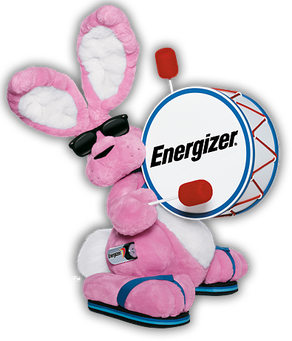
The Energizer Bunny is the marketing mascot of Energizer batteries in North America. It is a pink mechanical toy rabbit wearing sunglasses and blue and black striped flip-flops that beats a bass drum bearing the Energizer logo.

The AAA battery is a standard size of dry cell battery. One or more AAA batteries are commonly used in low-drain portable electronic devices. A zinc–carbon battery in this size is designated by IEC as R03, by ANSI C18.1 as 24, by old JIS standard as UM-4, and by other manufacturer and national standard designations that vary depending on the cell chemistry. The size was first introduced by The American Ever Ready Company in 1911. They're called #7 batteries in China, the name originating from the Burgess Battery Company designating his AAA batteries "Number 7".

The AA battery is a standard size single cell cylindrical dry battery. The IEC 60086 system calls the size R6, and ANSI C18 calls it 15. It is named UM-3 by JIS of Japan. Historically, it is known as D14, U12 – later U7, or HP7 in official documentation in the United Kingdom, or a pen cell.
In physics, energy density is the amount of energy stored in a given system or region of space per unit volume. It is sometimes confused with energy per unit mass which is properly called specific energy or gravimetric energy density.

Zinc–air batteries (non-rechargeable), and zinc–air fuel cells are metal–air batteries powered by oxidizing zinc with oxygen from the air. These batteries have high energy densities and are relatively inexpensive to produce. Sizes range from very small button cells for hearing aids, larger batteries used in film cameras that previously used mercury batteries, to very large batteries used for electric vehicle propulsion and grid-scale energy storage.

A D battery is a standardized size of a dry cell. A D cell is cylindrical with an electrical contact at each end; the positive end has a nub or bump. D cells are typically used in high current drain applications, such as in large flashlights, radio receivers, and transmitters, and other devices that require an extended running time. A D cell may be either rechargeable or non-rechargeable. Its terminal voltage and capacity depend upon its cell chemistry.
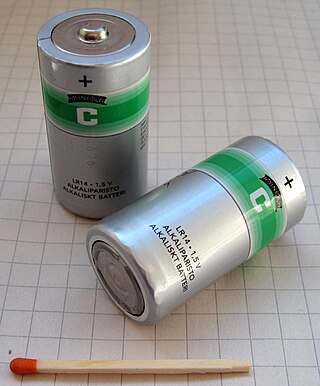
The C battery is a standard size of dry cell battery typically used in medium-drain applications such as toys, flashlights, and musical instruments.

Lithium metal batteries are primary batteries that have metallic lithium as an anode. The name intentionally refers to the metal to as to distinguish them from lithium-ion batteries, which use lithiated metal oxides as the cathode material. Although most lithium metal batteries are non-rechargeable, rechargeable lithium metal batteries are also under development. Since 2007, Dangerous Goods Regulations differentiate between lithium metal batteries and lithium-ion batteries.

The nine-volt battery, or 9-volt battery, is an electric battery that supplies a nominal voltage of 9 volts. Actual voltage measures 7.2 to 9.6 volts, depending on battery chemistry. Batteries of various sizes and capacities are manufactured; a very common size is known as PP3, introduced for early transistor radios. The PP3 has a rectangular prism shape with rounded edges and two polarized snap connectors on the top. This type is commonly used for many applications including household uses such as smoke and gas detectors, clocks, and toys.

A mercury battery is a non-rechargeable electrochemical battery, a primary cell. Mercury batteries use a reaction between mercuric oxide and zinc electrodes in an alkaline electrolyte. The voltage during discharge remains practically constant at 1.35 volts, and the capacity is much greater than that of a similarly sized zinc-carbon battery. Mercury batteries were used in the shape of button cells for watches, hearing aids, cameras and calculators, and in larger forms for other applications.
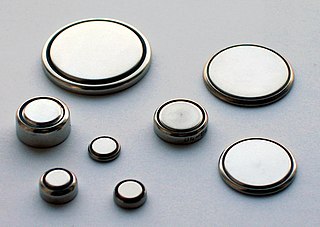
A button cell, watch battery, or coin battery is a small single-cell battery shaped as a squat cylinder typically 5 to 25 mm in diameter and 1 to 6 mm high – resembling a button. Stainless steel usually forms the bottom body and positive terminal of the cell; insulated from it, the metallic top cap forms the negative terminal.
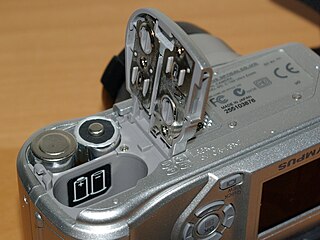
A CR-V3 battery is a type of disposable high-capacity 3-volt battery used in various electronic appliances, including some digital cameras. It has the shape and size of two side-by-side AA batteries. This allows CR-V3 batteries to function in many devices originally designed for only AA batteries. An RCR-V3 battery is a rechargeable 3.7 V lithium-ion battery.

The AAAA battery is 42.5 mm long and 8.3 mm in diameter. The alkaline cell weighs around 6.5 g and produces 1.5 V. This size battery is also classified as R8D425 (IEC) and 25 (ANSI/NEDA). The alkaline battery in this size is also known by Duracell type number MN2500 or MX2500 and Energizer type number E96.
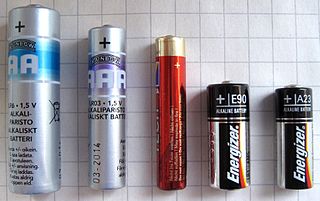
The A23 battery is a dry battery consisting of eight LR932 cells, with a nominal voltage of 12 V.

An electric battery is a source of electric power consisting of one or more electrochemical cells with external connections for powering electrical devices. When a battery is supplying power, its positive terminal is the cathode and its negative terminal is the anode. The terminal marked negative is the source of electrons that will flow through an external electric circuit to the positive terminal. When a battery is connected to an external electric load, a redox reaction converts high-energy reactants to lower-energy products, and the free-energy difference is delivered to the external circuit as electrical energy. Historically the term "battery" specifically referred to a device composed of multiple cells; however, the usage has evolved to include devices composed of a single cell.
This is a list of commercially-available battery types summarizing some of their characteristics for ready comparison.